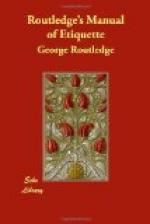In the matter of carving, it should be held in mind that the flavour and the digestibility of the meat depends greatly on the careful mode of cutting it. A delicate stomach may be disgusted with a thick coarse slice, an undue proportion of fat, a piece of skin or gristle; and therefore the carver must have judgment as well as dexterity, must inquire the taste of each guest, and minister discreetly to it. This delicate duty is more fully set forth in the direction for carving each dish. One point it is well to remember: never use a knife when you can help with a spoon. The lighting the dinner-table well is of some importance. People like to see their dinner, but lamps and candles on the table are liable to accidents. Gas is also objectionable; the heat from it is oppressive, and the light too glaring to be pleasant to the eyes, or becoming to female beauty: chandeliers with wax lights or a suspended and shaded lamp we would recommend as most favourable to the banquet and the company. Few dishes are now placed on the table at dessert. There should be at least three glasses placed before each guest, one of which must be of coloured glass, and water-tumblers here and there at hand. To each, also, a dessert-plate, a knife, fork, nut-crackers, and d’Oyley; the decanters of such wines as the host chooses to bring forth, on their proper stands; and salt-cellars, and sugar-vases with perforated ladles, must also be on the table.
When the lady of the house perceives that her female guests have taken the wine they wish, she signifies by a slight inclination the request to leave the table, and on her rising some chivalrous gentleman opens the door for the ladies to pass into the drawing-room, where it is the duty of the mistress of the house to offer the usual amusements to her friends—music, books of drawings, or conversation; but few efforts are required among well-bred guests.
Coffee should then be brought in. If only one servant be employed, every lady must prepare her own cup. When there are two servants, the cups are on one tray, and the second attendant follows with the coffee-pot, and fills the cup of each person.
If the gentlemen in the dining-room do not join the ladies immediately, coffee is served to them at table when required; and when they appear in the drawing-room, tea is handed round.
The greatest aid to the pleasure of a mixed party is that ease of manner which the habits of good society produce. When the hosts are composed and cheerful, the company commonly follow the example, and awkward restraint disappears.
* * * * *
CARVING.
Though in the present day no lady would be permitted to perform the heavier duties of carving for a large company unassisted, yet it is by no means inconsistent with the character of a well-bred woman to understand, and occasionally to practise, the duty. In the middle classes this duty is not unusually taken by the wife of a man whom business may often detain from his home; and a skilful and economical carver is no bad helpmate for a hard-working professional man.




